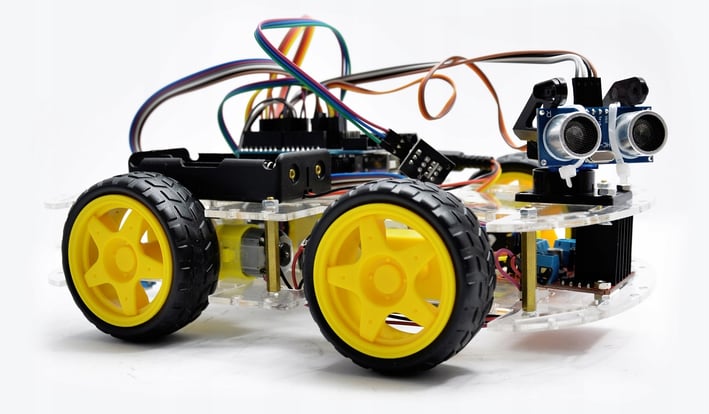Building Autonomous Robots: Challenges and Solutions
Creating autonomous robots involves navigating complex environments, avoiding obstacles, and making real-time decisions. This blog explores the challenges and solutions in autonomous robotics, offering practical techniques and case studies for enthusiasts and advanced students.
Vinay
5/18/20243 min read


Introduction:
Creating autonomous robots presents a fascinating yet complex challenge. Autonomous robots must navigate, avoid obstacles, and make decisions independently. In this blog, we'll delve into the primary challenges faced in developing autonomous robots and explore practical solutions and techniques to overcome these hurdles. This guide is tailored for robotics enthusiasts and advanced students looking to deepen their understanding of autonomous systems.
Challenges in Autonomous Robotics:
Navigation:
Problem: Autonomous robots need to determine their position and navigate to a target location accurately.
Challenges: GPS signal limitations indoors, environmental variability, and dynamic obstacles.
Obstacle Avoidance:
Problem: Robots must detect and navigate around obstacles in real-time.
Challenges: Sensor limitations, response time, and complex environments with unpredictable elements.
Decision-Making:
Problem: Autonomous robots must make intelligent decisions based on sensor inputs and environmental conditions.
Challenges: Balancing real-time processing with computational limits, uncertainty in sensor data, and implementing robust algorithms.
Techniques for Navigation and Obstacle Avoidance:
Sensor Fusion:
Solution: Combine data from multiple sensors (e.g., LIDAR, GPS, IMU, cameras) to improve accuracy and reliability.
Example: Using GPS for rough positioning and LIDAR for detailed environmental mapping.
Simultaneous Localization and Mapping (SLAM):
Solution: Implement SLAM algorithms to build a map of an unknown environment while simultaneously keeping track of the robot's location.
Example: Google Cartographer or GMapping for real-time 2D and 3D SLAM.
Path Planning Algorithms:
Solution: Use algorithms like A* (A-star), Dijkstra's, or Rapidly-exploring Random Tree (RRT) for efficient pathfinding.
Example: A* algorithm for grid-based environments to find the shortest path.
Reactive Control and Proactive Planning:
Solution: Combine reactive control (immediate response to obstacles) with proactive planning (preemptive route adjustment).
Example: Subsumption architecture for reactive behavior and Model Predictive Control (MPC)
for planning.
Machine Learning and AI:
Solution: Apply machine learning techniques for pattern recognition, decision-making, and adaptive learning.
Example: Reinforcement learning for optimizing navigation strategies through trial and error.
Case Studies and Practical Solutions:
Autonomous Delivery Robots:
Challenge: Navigating urban environments with pedestrians, vehicles, and varying terrains.
Solution: Use a combination of SLAM, computer vision for object detection, and robust path planning algorithms.
Example: Starship Technologies' delivery robots utilize multiple sensors and AI for real-time navigation and obstacle avoidance.
Self-Driving Cars:
Challenge: Ensuring safety and reliability in complex, dynamic environments.
Solution: Implement sensor fusion with LIDAR, radar, and cameras, along with deep learning for object detection and decision-making.
Example: Waymo's autonomous vehicles use extensive sensor arrays and advanced AI algorithms for navigation and safety.
Service Robots in Hospitality:
Challenge: Navigating indoor environments with dynamic human interactions.
Solution: Utilize indoor positioning systems (IPS), SLAM for map building, and social behavior algorithms for human-robot interaction.
Example: Relay robots by Savioke, which deliver items in hotels using advanced navigation and obstacle avoidance systems.
One of the Best Platform to Build Autonomous Robots:
The Mumbai Coding Lab: designed for students of different age groups. Including Future Ready courses like ScratchJr & Scratch, Raspberry Pi,Python, Arduino, Artificial Intelligence and Machine Learning & much more....,These hands-on robotics kits introduce students to robotics and coding concepts in a fun and accessible way, promoting creativity and experimentation.
The most important thing parents should look for while searching for robotics and coding schools is physical accessible distance and flexibility of physical one-to-one and online/virtual classes. At TMCL we are happy to offer both Physical one-to-one and Online classes as they prefer. Our Lab is located in Velentine Apartment Building in Malad East near Oberoi Mall.
Website Link: https://themumbaicodinglab.in/
The most important factor while choosing any after-school program like robotics and coding is affordability, the TMCL programs are easily affordable to anyone.
Conclusion:
Building autonomous robots is a multifaceted challenge that requires addressing navigation, obstacle avoidance, and decision-making. By leveraging advanced techniques like sensor fusion, SLAM, path planning algorithms, and machine learning, we can overcome these challenges. Through real-world case studies, we see the practical application of these solutions, paving the way for more sophisticated and reliable autonomous robots in various industries.
This comprehensive guide provides enthusiasts and advanced students with the knowledge and tools to tackle the complexities of autonomous robotics, driving innovation and progress in this exciting field.
